How To Freeze Bok Choy || Preserve Fresh Vegetables
When I learned that you could freeze bok choy, it was a game changer for me in the kitchen. This incredibly tasty vegetable is very quick to spoil, and it’s way too good to waste.
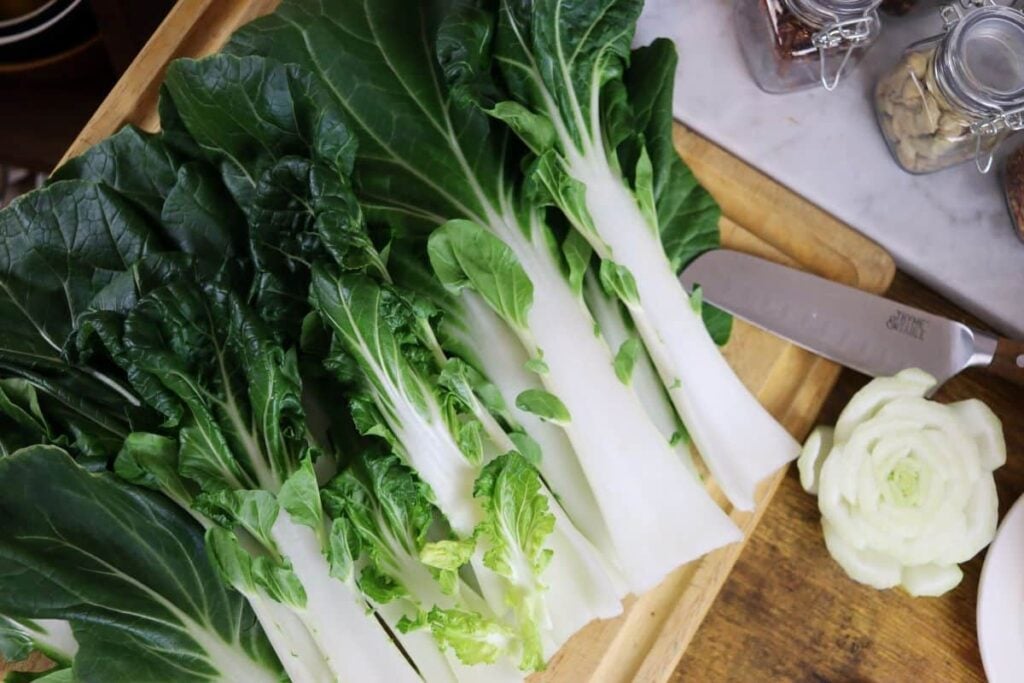
I tend to go more than a little overboard when buying leafy greens while shopping at farmers markets. I’ve never been able to get enough fresh vegetables as it is, I’m a big fan of the veggie kingdom.
And leafy vegetables are among my most favorites. Yes, I said MOST favorites! Don’t judge me!
This tendency to over purchase leafy greens has found me on a mission to eat them frantically for days so they don’t spoil on me. Sometimes it’s quite the challenge. Sometimes it can’t be done.
So, when I discovered that I could freeze fresh bok choy and have it on hand for future use, I felt like I won the lottery.
But it got better than that. I also found out that I could freeze cooked bok choy, and since there is no amount of bok choy that I don’t find worth saving, I was pretty happy about that too.
What Is Bok Choy?
Bok choy is leafy green deliciousness in your mouth. And really, in my opinion, that’s all that needs to be said about it. No further description is necessary.
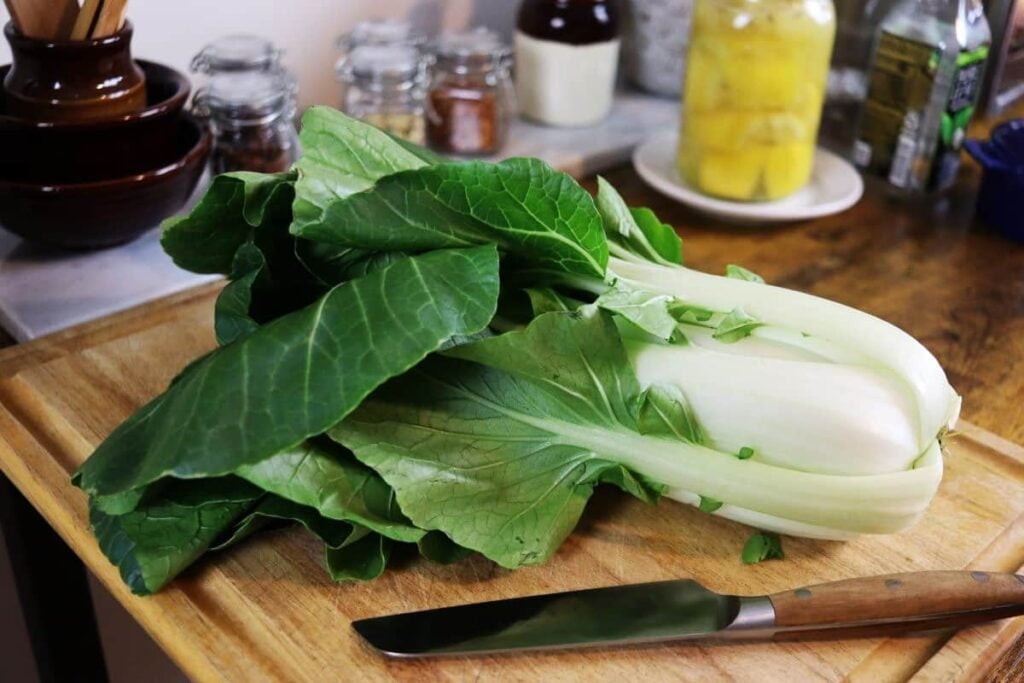
I think everyone on the planet should want to have leafy green deliciousness in their mouth!
But, in the spirit of providing you with all of the information you’re probably looking for about this veggie, I’ll tell you more.
It is part of the cabbage family, and it originated in China where it has been cultivated for thousands of years.
It has sweet, white stalks and ever-so-slightly bitter, tender leaves. It’s stalks are juicy and they have a crisp, crunchy texture that’s simply divine. I’ve heard it’s flavor compared to cabbage more times than I can count.
I suppose that is because it is a type of cabbage. But I have to say that the flavor of this vegetable doesn’t remind me of cabbage at all. It tastes like bok choy. It has a flavor all it’s own.
Bok choy can be eaten either raw or cooked. It is a nutrient-dense vegetable. And it is readily available in just about any grocery store.
But if you can find it at a local farm or farmers market, you’re in for a real treat. Because all vegetables taste better when they are not commercially grown.
I have the very good fortune of being able to purchase my bok choy from hydroponic farmers at my local farmers market. Their bok choy is absolutely out of this world. I’m a very lucky girl.

There are several different varieties of bok choy that are commonly sold in Asian countries. Among them are white bok choy, baby bok choy, Shanghai bok choy, and Tawainese bok choy.
Baby bok choy is a smaller, and more tender, variety of the bok choy that is commonly sold here in the United States. It too can often be found in grocery stores here in the states.
I have not found any other varieties of this veggie on the market here though. However, that may be the area that I live in. Perhaps there is more of a selection in other places.
You can buy seeds for many different varieties of this vegetable. And the second I have a space to garden in again, I will be growing this tasty vegetable myself.
Then … there will be an abundance of bok choy in my house. Like, ALL the bok choy.
Preparing Bok Choy For Freezing
I’m seeing it recommended, or at least suggested, that you blanch bok choy before you freeze it. Please don’t do that. I mean it’s your kitchen so you can go ahead and do as you think best.
But, if you’re here looking for guidance because you don’t know what’s best … I highly recommend that you do not blanch your bok choy before you freeze it. It’s just not a good idea.
As a matter of fact, it’s not recommended that you cook it in any way before you freeze it.
Now, with that said, if you have some leftover cooked bok choy and you want to put it in the freezer you can.
It will work reasonably well, and there’s no sense in wasting it. You can still make some use of it in the kitchen, it just doesn’t maintain it’s texture at the same level as it’s raw counterpart.
But, we’ll talk about that later.
So, if you want to get the best results preserving this vegetable, by freezing it for future use, then use the best freezing method. And that is to freeze unblanched bok choy.
All you need to do to prepare it to be frozen is clean it up and dry it thoroughly. Start by removing any undesirable parts of the vegetable; yellowing leaves, brown spots, or wilted pieces.
Then use your hands to wipe away any garden debris or dirt as you run it under cool water. If it has been grown organically grown there isn’t a concern about rinsing pesticides from the leaves.
The majority of the dirt should be in the bulbous base of the veggie. But , if it’s commercially grown, you will want to soak the entire plant in water (and maybe a splash of vinegar) to remove the pesticides before you freeze it.
After it’s washed, you’ll need to get it as dry as you possibly can. You don’t want to have any excess moisture on it when you freeze it. I use a flour sack towel to dry mine.
I lay the towel out on the counter, spread the bok choy out on top of it, and then fold the towel over the top of the bok choy and gently pat it dry. Doing this removes the excess water nicely.

It’s the best method I’ve come up with so far. However, I have seen it recommended that you use a salad spinner to remove the moisture from your bok choy before you freeze it.
This is a great idea and I know from using one in the past that it would work really well.
However, I haven’t owned a salad spinner in years. So, I use my flour sack towels.
It takes a bit more time to do it this way, but we’re really talking about just a few minutes here and I don’t have to store or wash a salad spinner. So, I think I’m winning at this game!
After the bok choy is clean, and as dry as you can get it, you will want to use a sharp knife to cut it into smaller pieces; 1-2 inch pieces work great.
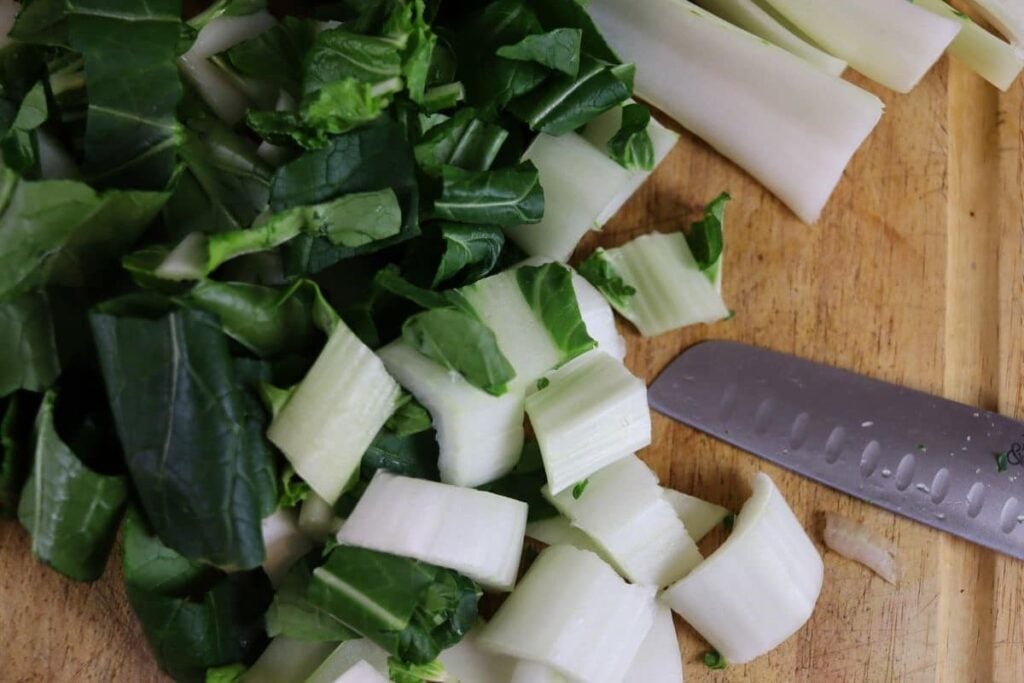
Would you like to save this post for later?
Don’t cut it too small. It won’t be as nice when it thaws.
At this point, you are ready to get this tasty veggie in the freezer so your kitchen days can have amazing bok choy goodness in them whenever the mood strikes you.
How To Freeze Raw Bok Choy
This veggie, like other fruits and veggies, should be frozen in a single layer before it is placed in an airtight container and frozen long term. It doesn’t completely prevent it from sticking together, as it does with many other fruits and vegetables.
But it still makes it much nicer to work with when you take it out of the freezer. It can be added to many dishes in it’s frozen state.
And since that’s the most practical way to go, you don’t want it to be frozen in a big ‘ol clump.
Spread it out over a baking sheet that has been lined with parchment paper. Put it in the freezer, and allow it to freeze completely.

This should not take more than a couple of hours. But I sometimes leave mine in there overnight.
Don’t leave it in there any longer than that though. You don’t want it to get freezer burnt.
Once it’s completely frozen, remove it from the freezer and put it in an appropriate freezer container.
Freezing bok choy in this way will result in the best quality product once it’s thawed. I don’t know of any better storage methods for this vegetable. As far as I’m concerned, this is the best way to go.
But, as I mentioned earlier, it is possible to freeze cooked bok choy. So if you find yourself with some leftover cooked bok choy that you don’t want to see go to waste, go ahead and put it in the freezer.
How To Freeze Cooked Bok Choy
There is really no ‘process’ involved when freezing cooked bok choy. You just need to be sure that it’s completely cool, place it in a freezer container, and put it in the freezer.
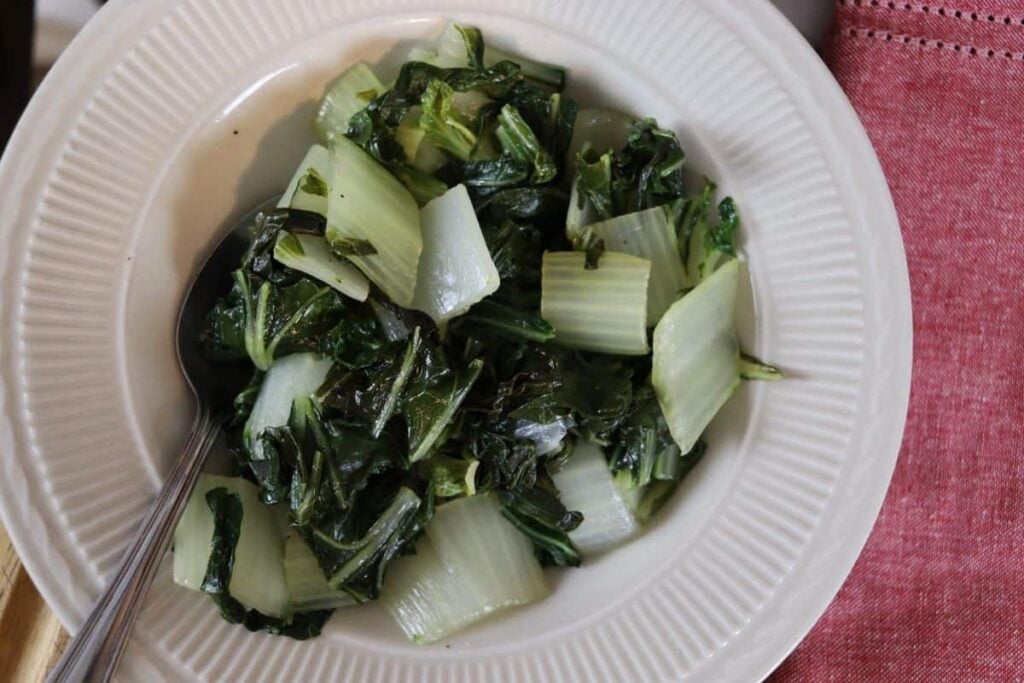
It isn’t a great way to go to preserve this vegetable. But it works. The issue with the method is that there is too much water in the bok choy, from the cooking process, and when it thaws it can be a bit of a mushy mess.
You won’t be able to use it in as many ways as you can use thawed raw bok choy. However, you can still use it in some dishes, and it’s nutritional value remains in tact. So that makes it worth saving.
How To Thaw Bok Choy
If you want to thaw your bok choy before you cook with it, there are several different ways that you can do this.
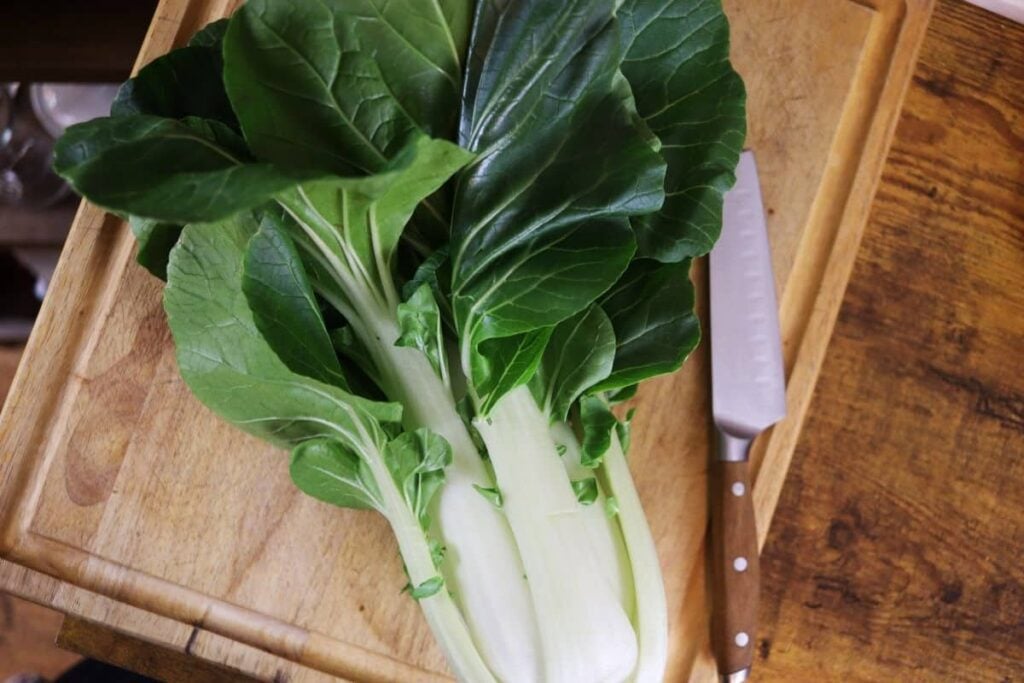
You can place it in a bowl of cold water and let it sit on the counter for about an hour or so and it will thaw nicely.
You can also remove it from the freezer the day before you are going to use it and put it in the refrigerator overnight to thaw.
I generally just leave mine sit at room temperature if I need to thaw it. I can’t imagine that the FDA considers this a safe food practice. So you do you.
I will say this though, it doesn’t take a long time to thaw. Maybe an hour or two. And you can safely leave refrigerated food out on the counter for up to 3 hours in a restaurant setting.
So, as long as you stay in that time frame, you can consider yourself FDA compliant.
As a rule, I don’t find that it’s necessary to thaw bok choy before cooking with it anyway. You can simply toss it in most dishes as they’re cooking, and it will thaw rather rapidly right there in the dish.
Note, that it will add extra moisture to the dish as it thaws. Therefore, depending on what it is that you’re cooking, you will need to make adjustments to the other liquids you are using in the dish to account for this.
Also note, that freezing bok choy changes the texture of the vegetable. This is the case when freezing many vegetables, and it is particularly true for leafy veggies.
It doesn’t make me love them any less though! And freezing this vegetable is still the best way to preserve it, in my opinion.
However, the crunchy texture of those crisp stems is not going to be the same when it thaws.
It really won’t make a great side dish at this point. So, don’t plan an thawing it out and serving it on a meat, potato, and veggie night.
But there are many other ways you can make really good use of thawed bok choy in the kitchen.
How To Use Thawed Bok Choy
Tossing thawed bok choy into soups and stews is a really great way to boost their nutritional value. And the texture change that the veggie undergoes during the freezing process is simply not noticable when it’s used in this way.
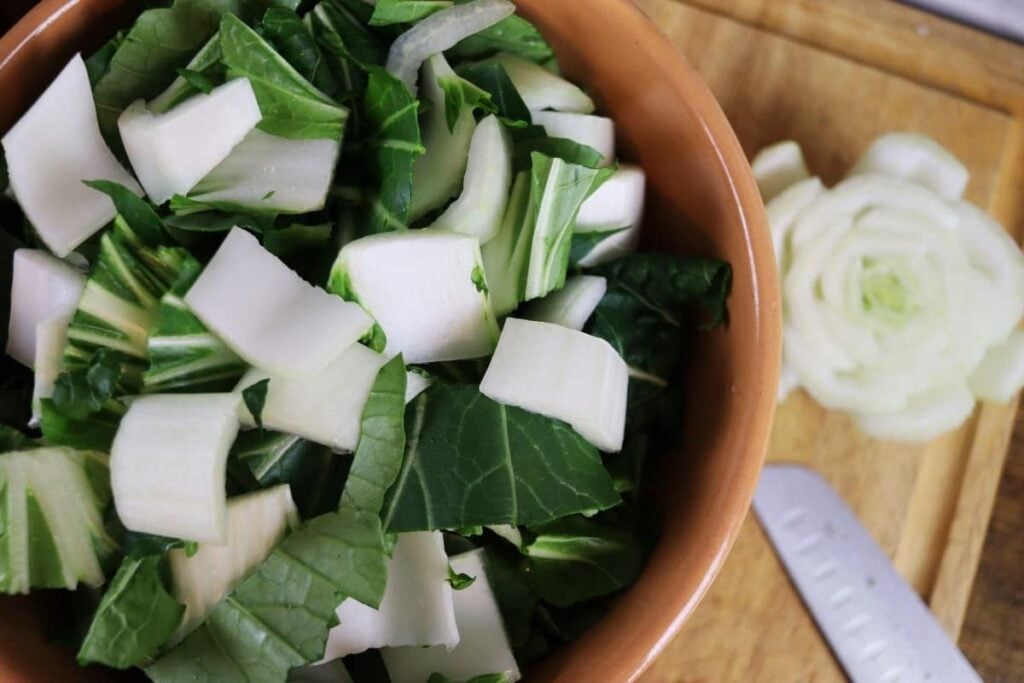
It also works out really well in a stir fry or a pasta dish. Same deal … it adds a nutritional boost without any undesirability arising from the texture change.
Casseroles, omelettes, quiche, and dips can be great options for using this thawed vegetable. The texture change doesn’t show up in these either.
I’ve even used it as a veggie pizza topping and in calzones and strombolis as well.
I’ve also mixed it into fillings. It’s great mixed in stuffed pastas of all kinds, think; ravioli, stuffed shells, manicotti, and lasagna. And it works in stuffings too.
You can use thawed cooked bok choy in all of these dishes as well. The thing is it is really pretty mushy after it’s been frozen and thawed. It just doesn’t hold up in the same way as raw bok choy when it’s frozen.
However, if you are simply wanting to give your dish a leafy green vegetable boost of nutrition, than you’re good to go. It will work best in a soup or a stew where it will pretty much go unnoticed.
Recommended For You
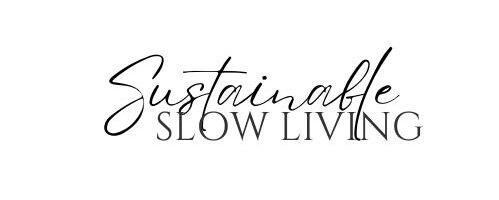
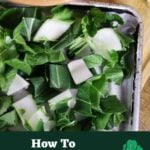

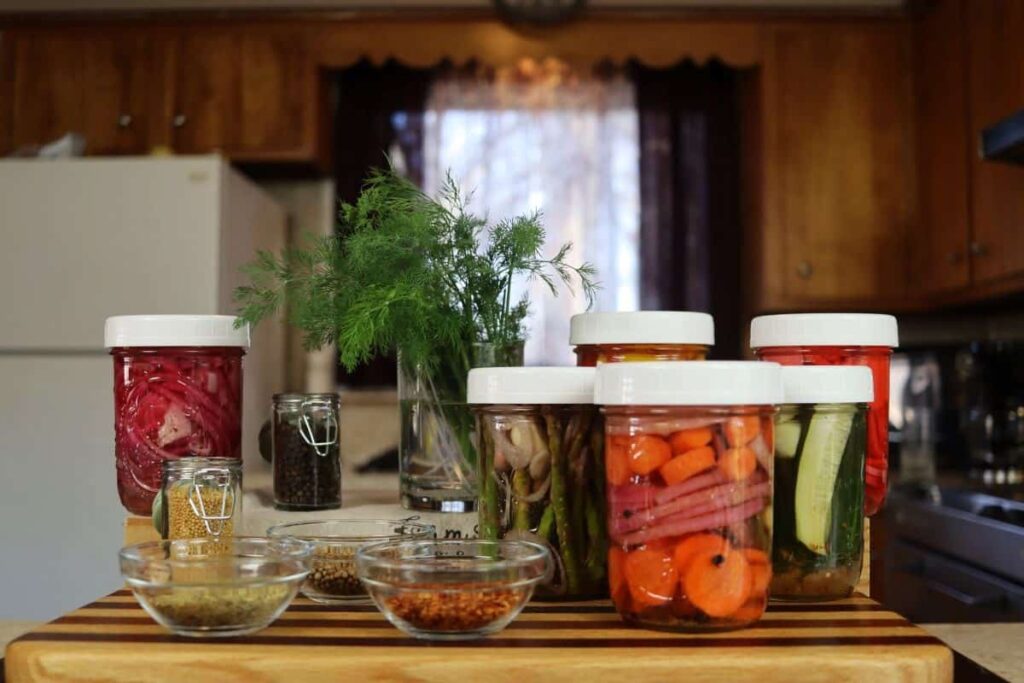

I’m so glad you wrote this. The first four picks of google search said blanche blanche blanche. Even when I included but I’m just going to simmer it in soup anyway so I don’t care if it’s a little mushy, they said blanche. I just wanted to preserve it long enough so that it doesn’t start developing language skills in the fridge.
I have to say that it is going to be a little mushy whether you blanche it or not. So why bother, right?!?! Glad this post was helpful for you. And I trust that with this method you won’t have any problems with your bok choy talking to you when it comes out of the freezer 😉
Freezing bok choy is a smart way to cut back on waste and keep this crisp, nutritious green on hand for stir-fries, soups, and more. This guide makes the whole process simple and approachable! If you try it out, I’d love to hear how you like to use your frozen bok choy — drop a comment below or ask any questions. Happy preserving!
Perfect timing! I just started harvesting my abundant bok choy today. Now I won’t lose so much of it. Thanks!
You are so very welcome!
Thank you! We live on a small island. This is my first year growing Pak Choy (Bok Choy) as part of a 12X24 garden. I had 2 patches. Planted indoors in March, transplanted among small onions. Good size by late May. 2nd patch is 4X4 with 20 plants almost ready. Appreciate your tips. Best wishes getting your garden back.
I’m so glad that my tips are useful for you. Sounds like you’re going to be enjoying some really great pak choy. YUM! And thanks for your best wishes. They are appreciated 😉